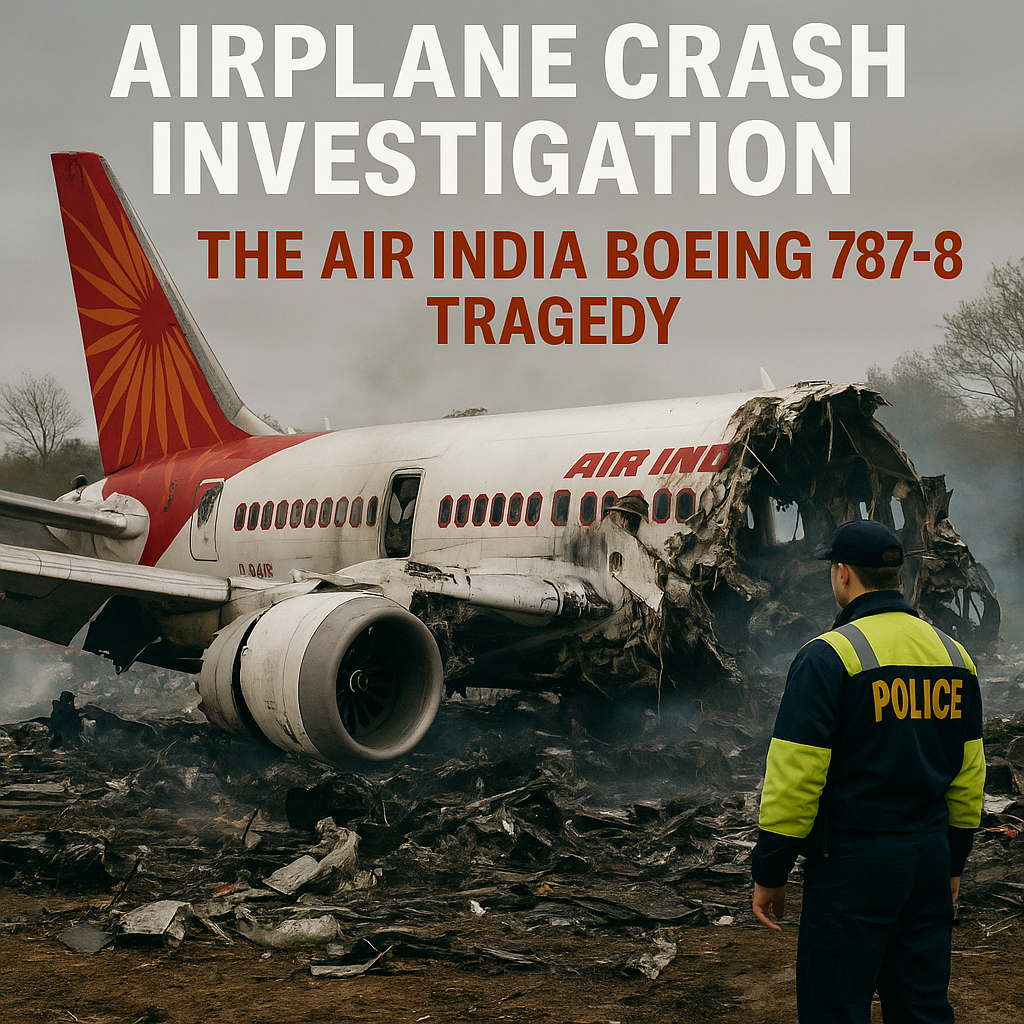On June 12, 2025, a catastrophic event shook the aviation world when an Air India Boeing 787-8 Dreamliner, carrying 242 passengers and crew, crashed moments after takeoff from Sardar Vallabhbhai Patel International Airport in Ahmedabad, India. The tragedy, which claimed 241 lives and left only one British survivor, has raised urgent questions about aviation safety, aircraft design, and the factors that may have contributed to the disaster. This blog post delves into the details of the crash, the ongoing investigation, and the broader implications for the aviation industry, drawing on available information and expert insights.
The Incident: A Devastating Loss
The Air India flight, bound for London, took off from Ahmedabad’s international airport under seemingly routine circumstances. However, just 1.5 kilometers (0.9 miles) from the runway, the Boeing 787-8 Dreamliner plummeted into a residential area, erupting in flames upon impact. Eyewitnesses described a harrowing scene: “The plane was in flames,” one resident told AFP, while another recalled hearing a “massive sound” that shook the neighborhood. The crash site was chaotic, with smoke billowing and local volunteers joining fire services to assist in rescue efforts. Tragically, the impact also caused feared casualties on the ground, though exact numbers remain unconfirmed.
The flight was operated by Captain Sumeet Sabharwal and co-pilot Clive Kundar, both highly experienced pilots with over 9,000 combined flying hours. Captain Sabharwal, with 22 years of expertise as a commercial airline pilot, was a seasoned aviator, making the sudden crash all the more perplexing. The sole survivor, a British man, has not been publicly identified, but his survival offers a glimmer of hope amid the devastation. Leicester East MP Shivani Raja noted that a “handful of Leicester residents” were believed to be on board, reflecting the personal toll felt by communities with strong British-Gujarati ties.
The Boeing 787-8 Dreamliner: A Modern Marvel Under Scrutiny
The Boeing 787-8 Dreamliner, introduced in 2011, is renowned for its advanced technology, fuel efficiency, and passenger comfort. This crash marks the first fatal incident involving this aircraft model, a significant milestone given its widespread use by airlines globally. The Dreamliner’s composite materials, advanced aerodynamics, and sophisticated avionics have made it a flagship for Boeing, but this tragedy has cast a spotlight on its safety record.
Preliminary reports suggest several potential causes for the crash, though investigators have yet to reach definitive conclusions. Experts cited by the BBC have pointed to possible issues such as a flap malfunction, engine failure, or a bird strike. Aviation expert Terry Tozer noted that video evidence suggested the aircraft’s flaps might not have been extended, which could explain difficulties in achieving proper lift during takeoff. Such a failure would be critical, as flaps are essential for generating the lift needed to climb safely.
The plane’s black boxes—comprising the flight data recorder and cockpit voice recorder—have not yet been analyzed publicly, but their recovery is a top priority. These devices will provide critical data on the aircraft’s systems, pilot actions, and environmental conditions in the moments leading up to the crash. Indian investigators, joined by experts from the United States and the United Kingdom, are working to piece together the sequence of events.
Investigating the Crash: A Complex Puzzle
Airplane crash investigations are among the most complex and meticulous processes in aviation. Conducted by national aviation authorities—in this case, India’s Directorate General of Civil Aviation (DGCA)—and often supported by international bodies like the National Transportation Safety Board (NTSB) and the UK’s Air Accidents Investigation Branch (AAIB), these investigations aim to identify the root cause of a crash and recommend measures to prevent future incidents.
Step 1: Securing the Crash Site
The first priority after the crash was securing the site to preserve evidence. Eyewitness accounts describe a chaotic scene, with debris scattered across a residential area and fires complicating access. Volunteers and emergency responders worked tirelessly, but the risk of evidence contamination is a concern in such scenarios. Investigators will have cordoned off the site to collect debris, analyze burn patterns, and locate critical components like the engines and flight control systems.
Step 2: Recovering the Black Boxes
The recovery of the black boxes is a pivotal moment in any crash investigation. These devices, designed to withstand extreme conditions, record thousands of parameters, including airspeed, altitude, engine performance, and pilot communications. Once retrieved, the black boxes will be analyzed in a controlled environment, likely with international oversight given the involvement of US and UK experts. The data will help reconstruct the flight’s final moments and identify anomalies, such as mechanical failures or unexpected pilot inputs.
Step 3: Examining the Aircraft and Maintenance Records
The Boeing 787-8 involved in the crash will be scrutinized for any signs of mechanical or structural failure. Investigators will review maintenance logs to determine whether the aircraft was properly serviced and whether any issues were reported prior to the flight. Air India, now owned by the Tata Group since its privatization in 2022, has faced scrutiny in the past for operational challenges, but there is no immediate evidence linking the airline’s practices to the crash.
Step 4: Human Factors and Pilot Performance
The experience of Captain Sabharwal and co-pilot Kundar suggests that pilot error is unlikely to be the sole cause, but human factors will still be examined. Investigators will analyze cockpit voice recordings to assess crew communication, decision-making, and adherence to standard operating procedures. Fatigue, situational awareness, and response to potential emergencies will also be considered.
Step 5: Environmental and External Factors
External factors, such as weather conditions or a bird strike, could have played a role. Ahmedabad’s airport is located in a busy urban area, and bird strikes are a known risk during takeoff and landing. Additionally, investigators will examine air traffic control communications to determine whether any instructions or miscommunications contributed to the crash.
Potential Causes: What Went Wrong?
While it’s too early to pinpoint the exact cause, several theories have emerged based on initial reports and expert commentary:
- Flap Malfunction: As noted by Terry Tozer, the aircraft’s flaps may not have been extended, reducing lift and causing the plane to stall shortly after takeoff. Flap issues could stem from mechanical failure, misconfiguration, or a failure in the aircraft’s control systems.
- Engine Failure: A loss of power in one or both engines could have prevented the aircraft from gaining altitude. The 787-8 is powered by advanced engines, such as the General Electric GEnx or Rolls-Royce Trent 1000, and investigators will examine whether a mechanical issue or foreign object damage (e.g., a bird strike) affected engine performance.
- Bird Strike: Birds can cause significant damage to aircraft, particularly during takeoff. A strike could have damaged an engine, windshield, or critical sensors, leading to a loss of control.
- Structural or System Failure: The 787-8’s reliance on advanced electronics and composite materials raises questions about potential system failures. Investigators will explore whether a fault in the fly-by-wire system, hydraulics, or other critical components contributed to the crash.
- Human Factors: While the pilots’ experience makes error less likely, investigators will consider whether a misjudgment, distraction, or failure to follow procedure played a role.
The Broader Context: Aviation Safety and Boeing’s Challenges
The Air India crash is a sobering reminder of the risks inherent in aviation, despite its status as one of the safest modes of transportation. The Boeing 787-8’s previously unblemished safety record made this incident particularly shocking. However, Boeing has faced significant scrutiny in recent years due to issues with its 737 MAX program, which was grounded globally after two fatal crashes in 2018 and 2019. While there is no immediate evidence of a design flaw in the 787-8, the crash will intensify scrutiny on Boeing’s manufacturing and quality control processes.
The aviation industry operates as a duopoly, with Boeing and Airbus dominating the market. This dynamic places immense pressure on both companies to maintain impeccable safety records. The Air India crash will likely prompt regulators to review the 787-8’s design and operational history, even as preliminary findings suggest no obvious fault on Boeing’s part.
Community Impact and Moving Forward
The crash’s impact extends beyond the aviation industry, deeply affecting communities in India and the UK. Leicester’s British-Gujarati community, in particular, has been devastated, with MP Shivani Raja describing the collective grief. The loss of 241 lives, including passengers and potentially residents on the ground, underscores the human toll of such tragedies.
Air India, under Tata Group ownership, has pledged full cooperation with the investigation. The airline’s history, from its founding in 1932 to its nationalization in 1953 and recent privatization, reflects its significance in Indian aviation. This tragedy will test its resilience and commitment to safety.
Conclusion: Seeking Answers and Ensuring Safety
The Air India Boeing 787-8 crash is a stark reminder of the complexities of modern aviation and the importance of rigorous safety protocols. As investigators from India, the US, and the UK work to uncover the cause, the global aviation community awaits answers that could shape future regulations, aircraft design, and operational practices. The recovery of the black boxes, analysis of wreckage, and examination of all possible factors will be critical in preventing similar tragedies.
For now, the focus remains on honoring the memory of the 241 victims and supporting the sole survivor and affected communities. This investigation will not only seek to explain what went wrong but also reinforce the aviation industry’s commitment to safety in an era of increasingly advanced technology.
Sources:




